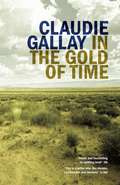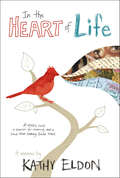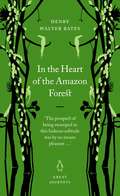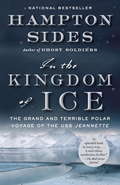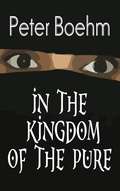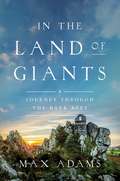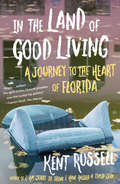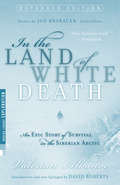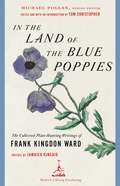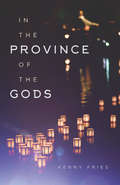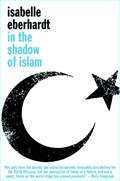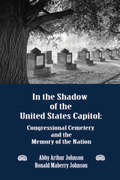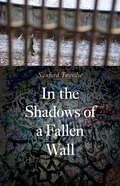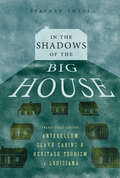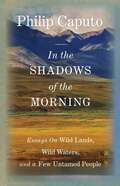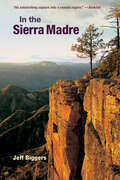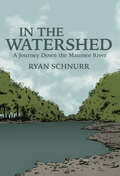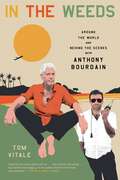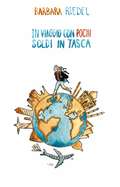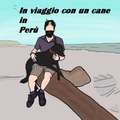- Table View
- List View
In the Gold of Time
by Claudie GallaySet between Normandy and Arizona, In the Gold of Time is a seductive tale of silences and dark, half-revealed secrets, and a haunting elegy for innocence lost in a lost world. A young father holidays by the sea near Dieppe with his reproachfully perfect wife and their twin daughters. Returning from the local shop, he meets an eccentric old lady, Alice Berthier, who lives with he mute sister, Clémence. Their mysterious house is full of old photographs and strange objects - sacred ceremonial masks once belonging to the Hopi, a tribe of Native Americans from Arizona. Haunted by memories of a tragic past, Alice takes comfort in her new companion, and he, in turn, is drawn into her mysterious world. As his family recedes into the background, her stirring tales of the Hopi and the Arizona desert become the only salve to his despondent soul.
In the Gold of Time
by Claudie GallaySet between Normandy and Arizona, In the Gold of Time is a seductive tale of silences and dark, half-revealed secrets, and a haunting elegy for innocence lost in a lost world. A young father holidays by the sea near Dieppe with his reproachfully perfect wife and their twin daughters. Returning from the local shop, he meets an eccentric old lady, Alice Berthier, who lives with he mute sister, Clémence. Their mysterious house is full of old photographs and strange objects - sacred ceremonial masks once belonging to the Hopi, a tribe of Native Americans from Arizona. Haunted by memories of a tragic past, Alice takes comfort in her new companion, and he, in turn, is drawn into her mysterious world. As his family recedes into the background, her stirring tales of the Hopi and the Arizona desert become the only salve to his despondent soul.
In the Heart of Life: A Memoir
by Kathy EldonA Mother Loses Almost Everything Before She Discovers True JoyIn 1977, Kathy Eldon moved with her husband and two children from England to Kenya, where she found freedom as she had never known it before and was ready to push back from her old, restrictive life. Diving into this tumultuous new world as a journalist and writer, she embraced the energy and creativity of Kenyans, both black and white. But her world collapsed when her twenty-two-year-old son, Dan—an artist and photojournalist on assignment for Reuters—was stoned to death by an angry mob in Somalia, killed by the very people he was trying to help. Kathy's journey through this tragic loss was deeply spiritual as she discovered that, in many ways, Dan was still ever-present in her life. This gripping international saga includes a passionate love, a dangerous coup in Kenya, and a compelling glimpse into a woman on the brink of self-discovery. After her son's murder, Kathy began to publish his art, which gained popularity worldwide and—together with her daughter, Amy—launched a global foundation celebrating Dan's work as a creative activist. Throughout Kathy's exploration of profound tragedy, we find the secrets to not only surviving, but being truly, gloriously alive.
In the Heart of the Amazon Forest: The Prospect Of Being Swamped In This Hideous Solitude Was By No Means Pleasant... (Great Journeys Ser.)
by Henry Walter BatesOne of the most impressive of all Victorian scientists but also a marvellous writer, Bates' (1825-1892) account of his years in the upper reaches of the Amazon is almost too good to be true - a great monument to human inquisitiveness as he battles great hoards of malevolent reptiles and insects in his quest for ever more obscure specimens on ever more narrow and creeper-choked tributaries.Great Journeys allows readers to travel both around the planet and back through the centuries – but also back into ideas and worlds frightening, ruthless and cruel in different ways from our own. Few reading experiences can begin to match that of engaging with writers who saw astounding things: Great civilisations, walls of ice, violent and implacable jungles, deserts and mountains, multitudes of birds and flowers new to science. Reading these books is to see the world afresh, to rediscover a time when many cultures were quite strange to each other, where legends and stories were treated as facts and in which so much was still to be discovered.
In the Heart of the Seas
by S. Y. Agnon I. M. LaskA story of a journey to the land of Israel, by the Nobel Prize winning author, with a dream-like atmosphere
In the Kingdom of Ice: The Grand and Terrible Polar Voyage of the USS Jeannette
by Hampton SidesNATIONAL BESTSELLER • A white-knuckle tale of polar exploration and heroism in the Gilded Age from the New York Times bestselling author of Blood and Thunder and Ghost Soldiers. • &“A splendid book in every way…a marvelous nonfiction thriller.&” —The Wall Street Journal On July 8, 1879, Captain George Washington De Long and his team of thirty-two men set sail from San Francisco on the USS Jeanette. Heading deep into uncharted Arctic waters, they carried the aspirations of a young country burning to be the first nation to reach the North Pole. Two years into the harrowing voyage, the Jeannette's hull was breached by an impassable stretch of pack ice, forcing the crew to abandon ship amid torrents of rushing of water. Hours later, the ship had sunk below the surface, marooning the men a thousand miles north of Siberia, where they faced a terrifying march with minimal supplies across the endless ice pack. Enduring everything from snow blindness and polar bears to ferocious storms and labyrinths of ice, the crew battled madness and starvation as they struggled desperately to survive. With thrilling twists and turns, In The Kingdom of Ice is a spellbinding tale of heroism and determination in the most brutal place on Earth.
In the Kingdom of the Pure: [None]
by Peter BoehmA fascinating description by German journalist Peter Boehm of his experiences while teaching English in Saudi Arabia.
In the Land of Giants: A Journey Through the Dark Ages
by Max AdamsA cultural exploration of the Dark Age landscapes of Britain that poses a significant question: Is the modern world simply the realization of our ancient past? The five centuries between the end of Roman Britain and the death of Alfred the Great have left few voices save a handful of chroniclers, but Britain's "Dark Ages" can still be explored through their material remnants: architecture, books, metalwork, and, above all, landscapes. Max Adams explores Britain's lost early medieval past by walking its paths and exploring its lasting imprint on valley, hill, and field. From York to Whitby, from London to Sutton Hoo, from Edinburgh to Anglesey, and from Hadrian's Wall to Loch Tay, each of his ten walking narratives form free-standing chapters as well as parts of a wider portrait of a Britain of fort and fyrd, crypt and crannog, church and causeway, holy well and memorial stone. Part travelogue, part expert reconstruction, In the Land of Giants offers a beautifully written insight into the lives of peasants, drengs, ceorls, thanes, monks, knights, and kings during an enigmatic but richly exciting period of Britain’s history.
In the Land of Good Living: A Journey to the Heart of Florida
by Kent RussellA wickedly smart, funny, and irresistibly off-kilter account of an improbable thousand-mile journey on foot into the heart of modern Florida, the state that Russell calls "America Concentrate."In the summer of 2016, Kent Russell--broke, at loose ends, hungry for adventure--set off to walk across Florida. Mythic, superficial, soaked in contradictions, maligned by cultural elites, segregated from the South, and literally vanishing into the sea, Florida (or, as he calls it: "America Concentrate") seemed to Russell to embody America's divided soul. The journey, with two friends intent on filming the ensuing mayhem, quickly reduces the trio to filthy drifters pushing a shopping cart of camera equipment. They get waylaid by a concerned citizen bearing a rifle; buy cocaine from an ex-wrestler; visit a spiritual medium; attend a cuckold party. The narrative overflows with historical detail about how modern Florida came into being after World War II, and how it came to be a petri dish for life in a suddenly, increasingly diverse new land of minority-majority cities and of unrivaled ethnic and religious variety. Russell has taken it all in with his incomparably focused lens and delivered a book that is both an inspired travelogue and a profound rumination on the nation's soul--and his own. It is a book that is wildly vivid, encyclopedic, erudite, and ferociously irreverent--a deeply ambivalent love letter to his sprawling, brazenly varied home state.
In the Land of White Death: An Epic Story of Survival in the Siberian Arctic (Modern Library Exploration)
by Valerian AlbanovIn 1912, six months after Robert Falcon Scott and four of his men came to grief in Antarctica, a thirty-two-year-old Russian navigator named Valerian Albanov embarked on an expedition that would prove even more disastrous. In search of new Arctic hunting grounds, Albanov's ship, the Saint Anna, was frozen fast in the pack ice of the treacherous Kara Sea-a misfortune grievously compounded by an incompetent commander, the absence of crucial nautical charts, insufficient fuel, and inadequate provisions that left the crew weak and debilitated by scurvy.For nearly a year and a half, the twenty-five men and one woman aboard the Saint Anna endured terrible hardships and danger as the icebound ship drifted helplessly north. Convinced that the Saint Anna would never free herself from the ice, Albanov and thirteen crewmen left the ship in January 1914, hauling makeshift sledges and kayaks behind them across the frozen sea, hoping to reach the distant coast of Franz Josef Land. With only a shockingly inaccurate map to guide him, Albanov led his men on a 235-mile journey of continuous peril, enduring blizzards, disintegrating ice floes, attacks by polar bears and walrus, starvation, sickness, snowblindness, and mutiny. That any of the team survived is a wonder. That Albanov kept a diary of his ninety-day ordeal-a story that Jon Krakauer calls an "astounding, utterly compelling book," and David Roberts calls "as lean and taut as a good thriller"-is nearly miraculous.First published in Russia in 1917, Albanov's narrative is here translated into English for the first time. Haunting, suspenseful, and told with gripping detail, In the Land of White Death can now rightfully take its place among the classic writings of Nansen, Scott, Cherry-Garrard, and Shackleton.
In the Land of the Blue Poppies: The Collected Plant-Hunting Writings of Frank Kingdon Ward (Modern Library Gardening)
by Jamaica Kincaid Tom Christopher Frank Kingdon WardA Modern Library Paperback OriginalDuring the first years of the twentieth century, the British plant collector and explorer Frank Kingdon Ward went on twenty-four impossibly daring expeditions throughout Tibet, China, and Southeast Asia, in search of rare and elusive species of plants. He was responsible for the discovery of numerous varieties previously unknown in Europe and America, including the legendary Tibetan blue poppy, and the introduction of their seeds into the world's gardens. Kingdon Ward's accounts capture all the romance of his wildly adventurous expeditions, whether he was swinging across a bottomless gorge on a cable of twisted bamboo strands or clambering across a rocky scree in fear of an impending avalanche. Drawn from writings out of print for almost seventy-five years, this new collection, edited and introduced by professional horticulturalist and House & Garden columnist Tom Christopher, returns Kingdon Ward to his deserved place in the literature of discovery and the literature of the garden.
In the Province of the Gods
by Kenny FriesKenny Fries embarks on a journey of profound self-discovery as a disabled foreigner in Japan, a society historically hostile to difference. As he visits gardens, experiences Noh and butoh, and meets artists and scholars, he also discovers disabled gods, one-eyed samurai, blind chanting priests, and A-bomb survivors. When he is diagnosed as HIV positive, all his assumptions about Japan, the body, and mortality are shaken, and he must find a way to reenter life on new terms.
In the Shadow of Islam
by Isabelle EberhardtAn extraordinary evocation of the desert and its people by a woman who dressed as a man in order to travel alone and unimpeded throughout North Africa In 1897 Isabelle Eberhardt, at the age of 20, left an already unconventional life in Geneva for the Morroccan frontier. Gripped by spiritual restlessness and the desire to break free from the confinements of her society she traveled into the desert, and into the heart of Islam. Her experiences inspired a profound self-examination, and a book that today is regarded as one of the true classics of travel writing. In the current political climate, it is also a book uncannily current in its treatment of the culture of Islam in North Africa. One of the most astonishing travel documents of all time, this book is also a feminist classic in its own right.
In the Shadow of the United States Capitol: Congressional Cemetery and the Memory of the Nation
by Abby Arthur Johnson Ronald M. JohnsonA fascinating study of America’s first national burial ground, with photos: “It’s stunning to realize what a who’s who exists in that space.” —Howard Gillette, Professor Emeritus, Rutgers University at CamdenThis study explores the multiple ways in which Congressional Cemetery has been positioned for some two hundred years in “the shadow” of the U.S. Capitol. The narrative proceeds chronologically, discussing the burial ground during three periods: the antebellum years; the years from the end of the Civil War to approximately 1970, when the site progressively deteriorated; and the period from the early 1970s to 2007, when both public and private organizations worked to preserve the physical site and the memory of what it has been and continues to represent. This monograph focuses on the dominant narrative associated with the site: its legacy as the first national burial ground in the nation. Given this emphasis, the text presents a political and cultural analysis of the cemetery, with particular focus on the participation of the U.S. Congress. “This book makes historians and many others aware of a fascinating and complicated history. Moreover, it not only details the long history of the cemetery, but it uses it to explore the nature of historic memorials generally in the creation of national memory.” —Steven Diner, Chancellor of Rutgers University at Newark“The history of Congressional Cemetery is intimately tied up in the changing demographics of its locale, and its corresponding decline as the neighborhood around Christ Church changed led to its emergence as a cause célèbre for historic preservationists.” —Donald Kennon, Chief Historian for the United States Capitol Historical Society and editor of The Capitol Dome“The Johnsons have done an excellent job of mining a wide range of sources and conveying the complex history of an institution that merits documentation.” —Howard Gillette, Professor Emeritus, Rutgers University at Camden
In the Shadows of a Fallen Wall
by Sanford TweedieGrowing up, what Sanford Tweedie knew about East Germany was basically . . . nothing. West Germans were our friends; East Germans, the enemy. In 2000, somewhat better informed, Tweedie took advantage of a Fulbright Scholarship to move his family to the eastern German town of Erfurt for the academic year. Far from home and the familiar, with temporary status and a tenuous grasp of the language, he and his wife were curious to see how they would function shorn of all the rules that governed their daily lives—housing, food acquisition, transportation, and even basic communication. As soon as their taxi delivered them to their grim tan and concrete Soviet-vintage apartment building, they knew their education had begun.Learning about life in the former East Germany, amid the feverish embrace of Western culture and the tenacious legacy of a totalitarian past, Tweedie comes to understand the deeper cultural assumptions through which Americans view the larger world. Part travelogue, part history, part cultural critique, all thoroughly engrossing, the story of his yearlong experience is one of dislocation and accommodation, making a German town his own and now ours.
In the Shadows of the Big House: Twenty-First-Century Antebellum Slave Cabins and Heritage Tourism in Louisiana (Atlantic Migrations and the African Diaspora)
by Stephen SmallIn the midst of calls for the removal of Confederate monuments across the South, tens of thousands of museums, buildings, and other historical sites currently comprise a tourist infrastructure of the southern heritage industry. Louisiana, one of the most prominent and frequently visited states that benefit from this tourism, has more than sixty heritage sites housed in former slave plantations. These sites contain the remains, restorations, reconstructions, and replicas of antebellum slave cabins and slave quarters. In the Shadows of the Big House: Twenty-First-Century Antebellum Slave Cabins and Heritage Tourism in Louisiana is the first book to tackle the role, treatment, and representation of slave cabins at plantation museum sites in contemporary heritage tourism.In this volume, author Stephen Small describes and analyzes sixteen twenty-first-century antebellum slave cabins currently located on three plantation museum sites in Natchitoches, Louisiana: Oakland Plantation, Magnolia Plantation Complex, and Melrose Plantation. Small traces the historical trajectory of plantations and slave cabins since the Civil War and explores what representations of slavery and slave cabins in these sites convey about the reconfiguration of the past and the rearticulation of history in the present. Considering such themes as the role of white ethnic identity in representations of elite whites and the extent and significance of Black voices and Black visions of representations of these plantations, Small asks what these sites reveal about social forgetting and social remembering throughout Louisiana and the South. He further explores the ways that gender structures the social organization of current sites and the role and influence of the state in the social organization and representations that prevail today.
In the Shadows of the Morning: Essays on Wild Lands, Wild Waters, and a Few Untamed People (Signed by the author)
by Philip CaputoPhilip Caputo's passion for travel and adventure was inspired by the works of Joseph Conrad, Jack London, and Herman Melville, and through the years this passion led to a rugged writer's life, filled with hair-raising experiences in the jungles of Vietnam, the rubble of Beirut, and the savannas of Africa. In the Shadows of the Morning collects Caputo's essays for the first time, each imbued with the powerful and memorable writing for which he has become so well known.In "The Ahab Complex," Caputo recalls a life-and-death struggle with a majestic giant blue marlin off the coast of Florida whose quarter-ton body "lit up as if a gigantic light had flashed in the water." He recounts his travels in Kenya's largest national park among the only lions to have a natural tendency to stalk and eat human beings, and where the accounts of their gruesome escapades invaded his dreams. In the title piece, he reflects on a harrowing trip down the Alaskan river that nearly claimed his son's life, nature's indifference to human loss, and an evocative account of letting go.In the Shadows of the Morning is a fascinating journey through a lifetime of profound experiences. Adventurers and lovers of great writing will welcome this collection of finely crafted essays by one of America's most gifted writers.
In the Sierra Madre
by Jeff BiggersA stunning history of legendary treasure seekers and enigmatic natives in Mexico's Copper Canyon The Sierra Madre--no other mountain range in the world possesses such a ring of intrigue. In the Sierra Madre is a groundbreaking and extraordinary memoir that chronicles the astonishing history of one of the most famous, yet unknown, regions in the world. Based on his one-year sojourn among the Raramuri/Tarahumara, award-winning journalist Jeff Biggers offers a rare look into the ways of the most resilient indigenous culture in the Americas, the exploits of Mexican mountaineers, and the fascinating parade of argonauts and accidental travelers that has journeyed into the Sierra Madre over centuries. From African explorers, Bohemian friars, Confederate and Irish war deserters, French poets, Boer and Russian commandos, Apache and Mennonite communities, bewildered archaeologists, addled writers, and legendary characters including Antonin Artaud, B. Traven, Sergei Eisenstein, George Patton, Geronimo, and Pancho Villa, Biggers uncovers the remarkable treasures of the Sierra Madre.
In the Watershed: A Journey Down the Maumee River
by Ryan Schnurr&“An engaging narrative . . . braiding together [Schnurr&’s] personal observations with history, science, and folklore.&” —Scott Russell Sanders, author, Earth Works: Selected Essays and A Conservationist Manifesto For several years, Ryan Schnurr watched media coverage of Lake Erie algae blooms with a growing sense of unease. An Indiana native, he wanted to learn more about role of the Maumee River in the lake&’s environmental woes: the Maumee is Lake Erie&’s largest tributary and the center of the largest watershed in the region, spanning more than 6,600 square miles of land. So in the summer of 2016, Schnurr walked and canoed the length of the river from its headwaters in Fort Wayne, Indiana to its mouth in Toledo, Ohio. In The Watershed: A Journey Down the Maumee River is the story of that voyage. As he walks the banks, Schnurr tells us the history of the river, from its formation by glaciers, function in Native American and American history, uses by industry, and role in current economic and environmental issues. Part cultural history, part nature writing, and part narrative, In the Watershed is a lyrical work of non-fiction with a timely and important warning at the core. &“What is happening in Lake Erie,&” Schnurr tells us, &“is a disaster by nearly any measure—ecologically, economically, socially, culturally.&” &“The Maumee River [is] a rich, complex, and fragile place, and Schnurr is a superb guide through it.&” —Mark Athitakis, author, The New Midwest: A Guide to Contemporary Fiction of the Great Lakes, Great Plains, and Rust Belt &“Delightful.&” —Luis Alberto Urrea, author, The Devil&’s Highway and Into the Beautiful North
In the Weeds: Around the World and Behind the Scenes with Anthony Bourdain
by Tom VitaleAnthony Bourdain's long time director and producer takes readers behind the scenes to reveal the insanity of filming television in some of the most volatile places in the world and what it was like to work with a legend. In the nearly two years since Anthony Bourdain's death, no one else has come close to filling the void he left. His passion for and genuine curiosity about the people and cultures he visited made the world feel smaller and more connected. Despite his affable, confident, and trademark snarky TV persona, the real Tony was intensely private, deeply conflicted about his fame, and an enigma even to those close to him. Tony&’s devoted crew knew him best, and no one else had a front-row seat for as long as his director and producer, Tom Vitale.Over the course of more than a decade traveling together, Tony became a boss, a friend, a hero and, sometimes, a tormentor.In the Weeds takes readers behind the scenes to reveal not just the insanity that went into filming in some of the most far-flung and volatile parts of the world, but what Tony was like unedited and off-camera. From the outside, the job looked like an all-expenses-paid adventure to places like Borneo, Vietnam, Iran, the Democratic Republic of Congo, and Libya. What happened off-camera was far more interesting than what made it to air. The more things went wrong, the better it was for the show. Fortunately, everything fell apart constantly.
In viaggio con pochi soldi in tasca
by Elena Tonazzo Barbara Riedel«Perché mi reputo in grado di dare consigli in materia di Low Budget Travelling? Sono partita per il mio grande viaggio con una disponibilità di denaro inferiore a 7000 euro (biglietti aerei a parte). Ho guadagnato un po’ mentre ero in giro. Contando anche il Round the World Ticket, alla fin fine, in 8 mesi, ho speso quasi esattamente 8050 euro tutto compreso. In teoria avrei potuto spendere anche meno, ma ho preferito spostarmi in continuazione, ho fatto tante escursioni, visto tanti posti e vissuto tante esperienze. Se ci ripenso, mi sembra incredibile. Ho viaggiato in 4 continenti e in 13 Paesi. Solo in Sudamerica mi sono lasciata alle spalle 20.000 chilometri coi pullman a lunga percorrenza. In viaggio con pochi soldi in tasca è un breve manuale a integrazione di Il mio giro del mondo – Un sogno che si avvera, il libro in cui racconto gli alti e bassi di questa mia avventura.» In viaggio con pochi soldi in tasca è una raccolta di dritte e consigli per viaggiatori low budget basata sull’esperienza dell’autrice negli ambiti: -Mezzi di trasporto -Pernottamento -Mangiare e bere -Luoghi da non perdere & tempo libero In viaggio con pochi soldi in tasca si rivolge in particolare a chi ha spirito di adattamento e di avventura e vorrebbe girare il mondo, ma pensa di non poterselo permettere. È per chi non sdegna consigli su come spendere il meno possibile per stare in giro il più possibile. Da ultimo ma non meno importante, è per chi ha simpatia per i nomadi digitali o ha una mezza idea di diventarlo. Schedule Schedule
In viaggio con un cane in Perù: Il viaggio di un ragazzo e del suo cane in Perù
by Bruno MaioranaAttraversare illegalmente il confine in Perù; una dettagliata descrizione di come intrufolarsi a Machu Picchu con un cane; rivelazioni psichedeliche dopo aver provato l'ayahuasca; tutto ciò che c'è da sapere sull'itinerario di trekking a Choquequirao; viaggiare sulla barca nell'Amazzonia peruviana e in Colombia e tanto tanto altr
In-Flight Fitness
by Andreas Reyneke Helen VarleyEverything you need to know to keep fit and healthy during air travel.Recently there has been more and more media attention on the potential health hazards of long-haul flights, whether it's 'economy class syndrome' or deep vein thrombosis, or merely jet-lag. Now, pilates expert Dreas Reyneke has put together the perfect guide which tells you everything you need to know, and everything you need to do, for a healthy flight.Reyneke's programme works for all passengers at any stage of a flight, whether it's the nervous minutes before take-off or the hours holed up in transit. It is designed to help all travellers, from elderly passengers on short flights, to business travellers settling down to sleep on an intercontinental overnight flight. It even works for travellers on a bus tour or trans-continental rail trip.Ranging from preparations for travel, the effects of travel on your body, recognising any early warning signs of illness and even causes of stress such as fear of flying, IN-FLIGHT FITNESS is the essential companion for any traveller.
In-Flight Fitness
by Andreas Reyneke Helen VarleyEverything you need to know to keep fit and healthy during air travel.Recently there has been more and more media attention on the potential health hazards of long-haul flights, whether it's 'economy class syndrome' or deep vein thrombosis, or merely jet-lag. Now, pilates expert Dreas Reyneke has put together the perfect guide which tells you everything you need to know, and everything you need to do, for a healthy flight.Reyneke's programme works for all passengers at any stage of a flight, whether it's the nervous minutes before take-off or the hours holed up in transit. It is designed to help all travellers, from elderly passengers on short flights, to business travellers settling down to sleep on an intercontinental overnight flight. It even works for travellers on a bus tour or trans-continental rail trip.Ranging from preparations for travel, the effects of travel on your body, recognising any early warning signs of illness and even causes of stress such as fear of flying, IN-FLIGHT FITNESS is the essential companion for any traveller.
Ina's Kitchen: Memories and Recipes from the Breakfast Queen
by Ina Pinkney Christina Silvestris Stephen HamiltonIna Pinkney--the beloved restaurateur known affectionately as the "Breakfast Queen"--has been feeding Chicago for more than 30 years. When she closed her namesake restaurant's doors in 2013, it headlined news across the Midwest. Now, the favorite dishes that thousands came to love at Ina's are showcased in the first paperback edition of her newly retitled book, Ina's Kitchen: Taste Memories and Recipes from the Breakfast Queen. Ina first self-published this book in hardcover in 2014, and it has already sold thousands of copies with minimal bookstore distribution. Ina's Kitchen is part cookbook part memoir, collecting 39 of Ina's favorite recipes with stories from her life. From milestone moments and warm memories to the "truth" about owning a restaurant, readers will gain a deeper understanding of one of Chicago's best-known culinary icons. Ina views her life as a recipe, and the book's chapters reflect that notion. From "Ingredients" and "Preparation" to "Clean Up," readers will come to understand what inspired and drove Ina's love of food--and her culinary success. Recipes include everything from Ina's signature Blobbs and Heavenly Hots to Foolproof Pancakes and Baked French Toast. In addition to breakfast favorites, Ina has also included savory dishes and dessert recipes. Ina's Kitchen is a love letter to the diners Ina has fed over the years. In it, she shares her wisdom with the same generosity--both of food and of spirit--that kept people coming back to her restaurant for decades.
